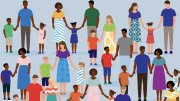A seductive story can stick in the public’s consciousness like a too-catchy tune. Harvard sociologist Christina Cross has spent nearly a decade trying to dispel the power of one tall tale that grips American society: the notion that an easy remedy for racial inequality is to reduce the number of Black children raised in single-parent households.
This idea has its roots in a report that sociologist—and later U.S. senator—Daniel Patrick Moynihan wrote in 1965, the same year he joined the Harvard faculty. U.S. President Lyndon B. Johnson had asked Moynihan to investigate why nearly 50 percent of African American families lived at or below the poverty line. After analyzing government documents, such as census records, and consulting the existing sociological literature, Moynihan concluded that when Black children are raised by single mothers, they “flounder—and fail.”
That simple explanation for racial inequality was so compelling to Americans that even today, three of the four ways in which the U.S. welfare program aims to lift families out of poverty involve promoting the two-parent structure. Every year, the U.S. government spends billions of dollars to advance this goal.
The truth, Cross argues in Inherited Inequality, her new book, is that American society gives Black kids “a perverse two-for-one discount.” Even when they do grow up with two parents, the outcome is too often the same as when white children grow up with one.
Cross reached this conclusion using data from three household surveys administered by academic researchers that, collectively, examined the lives of tens of thousands of Gen X and millennial youths. While two of those surveys follow kids from birth through young adulthood, the third took an in-depth look at the lives of American families during two years in the early 2000s. In contrast to Moynihan’s findings from the 1960s, these newer data show that cohabiting Black parents convey only a modest benefit to their children.
“If we think about family structure as being a great equalizer—as being the thing that’s going to make the difference and close gaps between groups,” Cross says, “then unfortunately we’re not going to witness that reduction in inequality that we’re expecting.”
To some people, this shift in evidence-based understanding may come as a surprise. After all, it makes intuitive sense that when two parents live together, they have twice as many opportunities to provide their children with financial, logistical, and emotional support as a parent who’s doing it all alone. And in fact, white children growing up in two-parent households do fare better academically than white children living with a single parent, in terms of high school academic success, the chance of finishing college, and income level in early adulthood.
But in Black families, the story is more complicated. Although Black children do tend to perform better in school when they live with both parents, their accomplishments are, on average, similar to what could be expected of a white child living with only one parent. On the flip side, living in a single-parent home doesn’t seem to lower Black children’s academic performance as much as it does their white peers’.
To investigate why, Cross asked whether the benefits of two-parent white families—more plentiful financial resources, adult supervision, and psychological wellbeing—extended fully to Black children in similar arrangements. “And the answer to that, unfortunately, is no,” she says. Systemic and cultural racism pervades America, she explains, from discrimination in the housing market to bias in the justice system. Consequently, even Black children who live with two parents are likely to face challenges, such as insufficient money and chronically depressed parents. These burdens are heavy enough to dwarf any benefit that comes with adding a second parent to the equation.
Inherited Inequality “beautifully exposes the man behind the curtain,” says Boston University sociologist Anthony Abraham Jack, Ph.D. ’16, who thinks the book could move American society past the two-parent myth. “Because the image of that may be good for postcards, but it’s not good for policy,” he says.
Cross began challenging the two-parent narrative publicly in 2019, when she published a New York Times opinion piece, “The Myth of the Two-Parent Family.” She hoped it would lead to social policy that could reduce racial inequality but says, instead, “I’ve seen policy changes in the opposite direction.” Upcoming cuts to social programs such as SNAP and Medicaid, she says, will likely increase the barriers Black children face and widen racial gaps in the United States. Likewise, the recent Supreme Court decision to end affirmative action in college admissions already seems to be reducing enrollment of Black students at some elite schools.
Cuts to SNAP and Medicaid, Cross fears, will increase the barriers Black children face.
Jack says he wouldn’t be surprised to see the achievement gap between Black and white kids widen in response to recent policy changes. “When you remove what protects us from the full weight of America’s history of racism and exclusion,” he explains, “we’re going to see this inequality only grow.”
Cross hopes her research can give policymakers the information they need to start changing that. Sixty years after the Moynihan report, Cross says she wants to tell a different story—“a much more sobering and complex one, but one that I think will help us to move in a more fruitful direction.”








